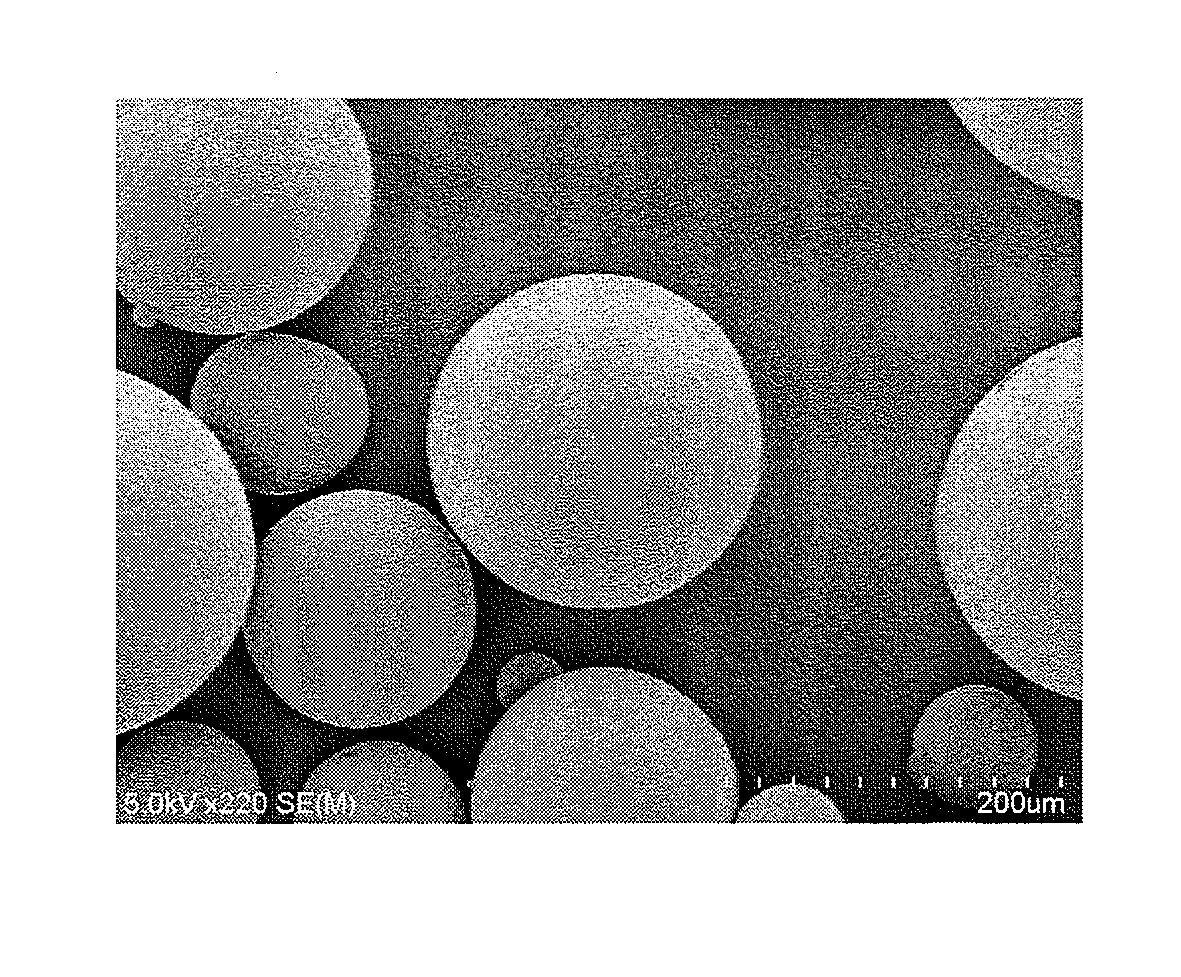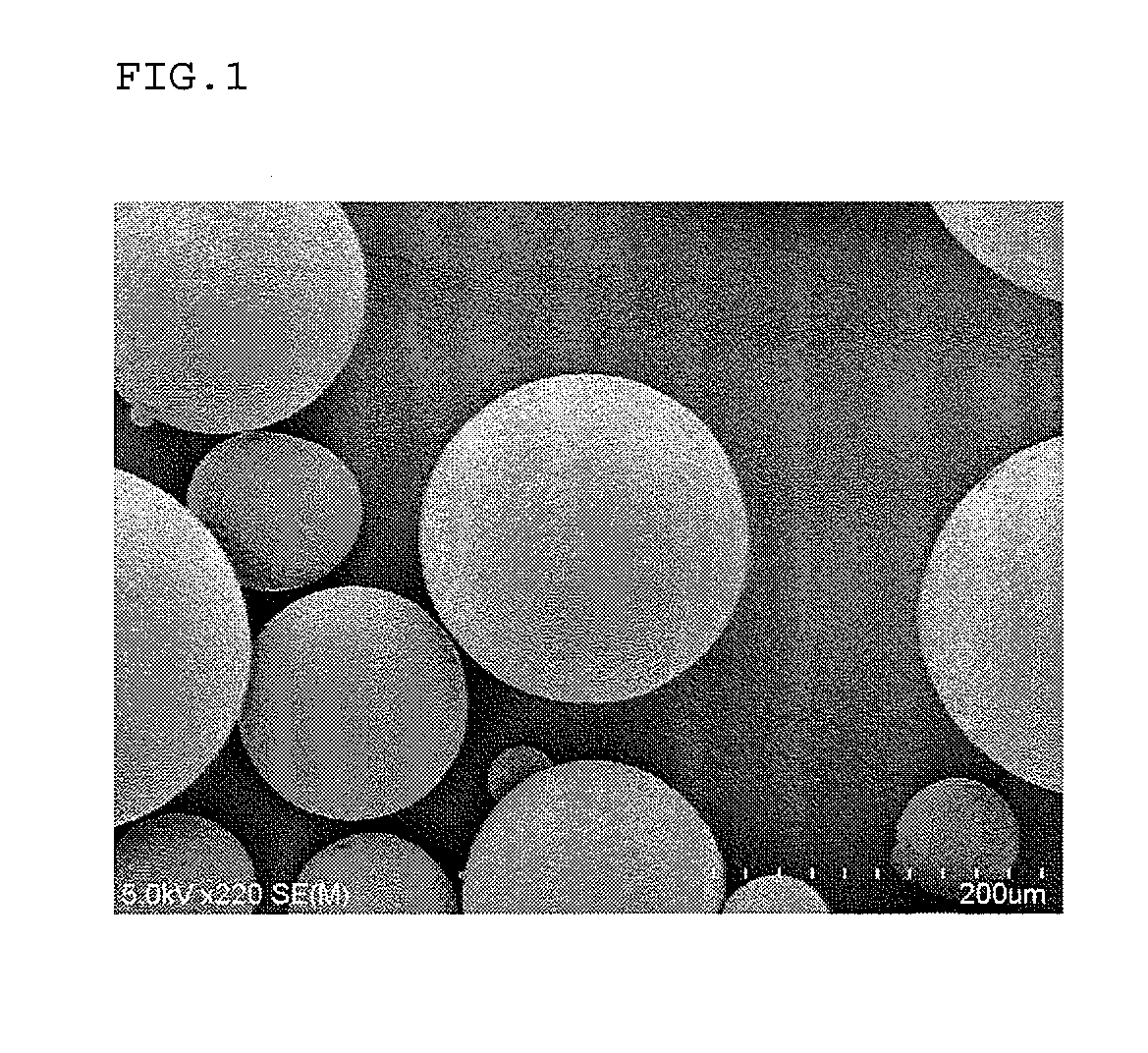Method for production of microcapsules using solid fat
a technology of solid fat and microcapsules, which is applied in the direction of anti-noxious agents, drug compositions, peptide/protein ingredients, etc., can solve the problems of difficult application and development, low degree of freedom of selectable particle size range, and problems of storage stability of microcapsules, etc., to achieve easy degradability, and increase the content of hydrophilic bioactive substances
- Summary
- Abstract
- Description
- Claims
- Application Information
AI Technical Summary
Benefits of technology
Problems solved by technology
Method used
Image
Examples
example 1
[0120]To an oily component consisting of 18 g of hydrogenated palm oil (melting point: 58° C.) and 0.9 g of tetraglycerol condensed ricinoleate (manufactured by Riken Vitamin Co., Ltd., POEM PR-100, HLB: 0.3) which had been heated to a temperature of 60° C. and melted beforehand was added 5 mL of an aqueous solution containing 20% by weight of glutathione (manufactured by Kaneka Corporation), followed by carrying out emulsification and dispersion at 63° C. with a homogenizer to prepare a W / O emulsion. Subsequently, the W / O emulsion was stirred for 30 min at a temperature of 70° C. under a vacuum condition with a pressure of 13 kPa to remove the moisture, whereby an S / O suspension was prepared. Thus resulting S / O suspension was added to 600 mL of an aqueous solution containing gum arabic (0.5% by weight) and decaglycerol monooleate (manufactured by Riken Vitamin Co., Ltd., POEM J-0381V, HLB: 12) (0.05% by weight) which had been heated to 60° C. beforehand. The mixture was stirred at ...
example 2
[0121]To an oily component consisting of 18 g of hydrogenated palm oil (melting point: 58° C.) and 0.9 g of tetraglycerol condensed ricinoleate (manufactured by Riken Vitamin Co., Ltd., POEM PR-100, HLB: 0.3) which had been heated to a temperature of 60° C. and melted beforehand was added 5 mL of an aqueous solution containing 30% by weight of glutathione (manufactured by Kaneka Corporation), followed by carrying out emulsification and dispersion at 63° C. with a homogenizer to prepare a W / O emulsion. Subsequently, the W / O emulsion was stirred for 30 min at a temperature of 70° C. under a vacuum condition with a pressure of 13 kPa to remove the moisture, whereby an S / O suspension was prepared. Thus resulting S / O suspension was added to 300 mL of an aqueous solution containing gum arabic (0.5% by weight) and decaglycerol monooleate (manufactured by Riken Vitamin Co., Ltd., POEM J-0381V, HLB: 12) (0.05% by weight) which had been heated to 60° C. beforehand. The mixture was stirred at ...
example 3
[0122]To an oily component consisting of 18 g of a fractionated palm fat (melting point: 42° C.) and 0.9 g of tetraglycerol condensed ricinoleate (manufactured by Riken Vitamin Co., Ltd., POEM PR-100, HLB: 0.3) which had been heated to a temperature of 50° C. and melted beforehand was added 5 mL of an aqueous solution containing 30% by weight of glutathione (manufactured by Kaneka Corporation), followed by carrying out emulsification and dispersion at 47° C. with a homogenizer to prepare a W / O emulsion. Subsequently, the W / O emulsion was stirred for 30 min at a temperature of 70° C. under a vacuum condition with a pressure of 13 kPa to remove the moisture, whereby an S / O suspension was prepared. Thus resulting S / O suspension was added to 300 mL of an aqueous solution containing gum arabic (0.5% by weight), decaglycerol monooleate (manufactured by Riken Vitamin Co., Ltd., POEM J-0381V, HLB: 12) (0.05% by weight) and ethanol (30% by volume) which had been heated to 50° C. beforehand. ...
PUM
| Property | Measurement | Unit |
|---|---|---|
| melting point | aaaaa | aaaaa |
| temperature | aaaaa | aaaaa |
| temperature | aaaaa | aaaaa |
Abstract
Description
Claims
Application Information
 Login to View More
Login to View More - R&D
- Intellectual Property
- Life Sciences
- Materials
- Tech Scout
- Unparalleled Data Quality
- Higher Quality Content
- 60% Fewer Hallucinations
Browse by: Latest US Patents, China's latest patents, Technical Efficacy Thesaurus, Application Domain, Technology Topic, Popular Technical Reports.
© 2025 PatSnap. All rights reserved.Legal|Privacy policy|Modern Slavery Act Transparency Statement|Sitemap|About US| Contact US: help@patsnap.com


